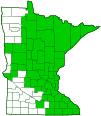green frog
(Lithobates clamitans)
Conservation • Description • Habitat • Biology • Distribution • Taxonomy
|
|
|||||||||||||
Description |
Green frog is a mid-sized, 2¼″ to 3½″ long, true frog. It is the second largest frog in Minnesota after only the American bullfrog. The back (dorsal surface) is smooth to moderately rough and green or brownish-green. It usually has small, irregular, dark spots and is usually brighter colored toward the front. Prominent folds on each side of the back (dorsolateral folds) extend from just behind the disk-shaped membrane covering the ear opening (tympanum) to just over halfway down the back. Another ridge begins just behind the eye and curves downward behind the tympanum. The side of the face is green. The tympanum on males is larger than the eye. On females it is about the same size as the eye. The belly is white and often has dark mottling on the throat, jaw, and under the hind legs. Males have a single inflatable vocal sac. It is internal, not visible. The throat on mature males is yellow. The hind legs have dark horizontal bands. The webbing on the hind feet extends to the tips of the first through third toes, to the second joint on the fourth toe, and not quite to the tip on the fifth toe. -------------------------------- |
Size |
2¼″ to 3½″ |
Voice |
The mating call is usually described as the sound of plucking a loose banjo string, “plunk”. The call is a single note but is often repeated. It can be heard from May through July. No other frogs in Minnesota sound similar. |
Similar Species |
American bullfrog (Rana catesbeiana) is larger. It lacks a dorsolateral ridge. |
Habitat |
Semi-permanent or permanent wetlands: large marshes, streams, deep ponds, larger lakes, and roadside ditches. |
Biology |
Behavior |
Green frogs are often seen on a shore within one quick leap to a body of water. They hunt by sitting still and waiting for prey to cross their path. |
Lifespan |
5 to 10 years |
Life Cycle |
Adults emerge from hibernation from April to June. Males call from May to July. Mating takes place in late spring or early summer. After mating, the female lays a single floating mass of 1,000 to 5,000 eggs in water. The mass is flat and about 12″ in diameter. The eggs hatch in 3 to 7 days, depending on temperature. Most tadpoles overwinter and metamorphose into adults the following spring. Males become sexually active one year after metamorphosis, females 2 or 3 years. Adults hibernate in the mud under debris, under stones, or under water that does not completely freeze. |
Tadpole Food |
Organic debris, algae, plant tissue, and minute organisms in the water. |
Adult Food |
Insects, crayfish, fish, snails, small snakes, other frogs—any animal that will fit in its mouth. |
Distribution |
||
|
Sources |
|
| 8/17/2024 | ||
Occurrence |
||
Common in eastern United States. At the western edge of its range in Minnesota. |
||
Taxonomy |
|
Class |
Amphibia (amphibians) |
Subclass |
Lissamphibia (modern amphibians) |
Superorder |
Batrachia (amphibians) |
Order |
Anura (frogs and toads) |
Suborder |
Neobatrachia |
Superfamily |
Ranoidea |
Family |
Ranidae (typical frogs) |
Genus |
Lithobates (American water frogs) |
Genus In 2016, a consortium of Rana researchers from Europe, Asia, and North America showed that transferring the species to Lithobates caused problems of paraphyly in other genera. In that same year, Yuan et al. returned all North American true frogs to the genus Rana, using subgenera for all of the well-defined species groups within Rana. AmphibiaWeb uses the name Rana clamitans. A recent article (Dubois, Alain et al., 2021) proposed a new “phylogenetic taxonomy and nomenclature” of extant amphibians (subclass Lissamphibia). In the proposed taxonomy, the subgenus Aquarana is raised to full species rank, and Lithobates clamitans becomes Aquarana clamitans. Amphibian Species of the World uses the name Aquarana clamitans. |
|
Subordinate Taxa |
|
Some authorities, including AmphibiaWeb and NatureServe, recognize two subspecies: the southern subspecies, bronze frog; and the northern subspecies, green frog, also called northern green frog. |
|
bronze frog (Lithobates clamitans clamitans) green frog (Lithobates clamitans melanota) |
|
Synonyms |
|
Aquarana clamitans Rana calamitans Rana clamata Rana clamator Rana clamitans Rana flaviviridis Rana fontinalis Rana horiconensis Rana nigricans Ranaria melanota |
|
Common Names |
|
bronze frog brown frog cow frog green frog |
|
Glossary
Dorsolateral folds
Two parallel lines, one on each side of the back, of raised glandular skin between the back and the sides of most North American frogs of the family Ranidae.
Tympanum
The circular, disk-like membrane that covers the ear opening of some reptiles and amphibians.
Visitor Photos |
||
Share your photo of this amphibian. |
||
This button not working for you? |
||
Luciearl |
||
 |
|
|
Tina Lonsky |
||
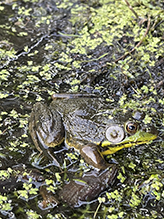 |
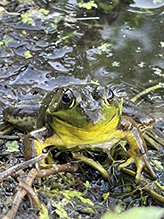 |
|
… from our pond |
||
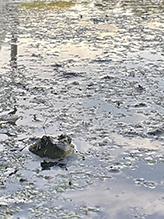 |
||
Robb |
||
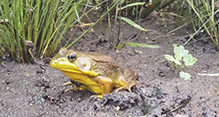 |
||
Brian Blom |
||
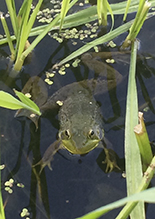 |
||
Christa Rittberg |
||
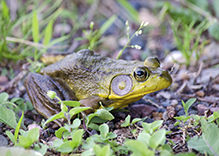 |
||
MinnesotaSeasons.com Photos |
||
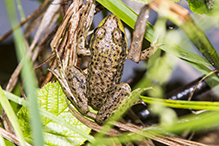 |
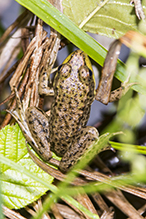 |
|
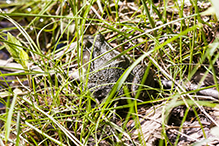 |
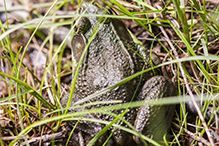 |
|
Male |
Male | |
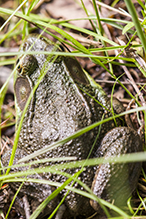 |
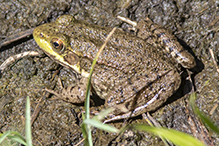 |
|
Male |
Female |

Slideshows |
Green Frog (Rana clamitans melanota) |

|
Rana clamitans (Green Frog) |

|
Rana clamitans (Green Frog) |

|

Visitor Videos |
||
Share your video of this amphibian. |
||
This button not working for you? |
||
|
Other Videos |
||
Green Frog |
About
Uploaded on Jul 31, 2011 Green Frog Description: 2 1/8-4 1/4" (5.4-10.8 cm). Green, bronze or brown frog; large external eardrum and prominent dorsolateral ridges that do not reach groin. Typically green on upper lip. Belly white with darker pattern of lines or spots. Male has yellow throat and swollen thumbs. Subspecies: Bronze (R. c. clamitans), brown or bronze; Carolinas to c. Florida and through the gulf coast states to e. Texas and s. Arkansas. Northern Green (R. c. melanota), green or greenish-brown; s. Ontario east to Newfoundland, south to North Carolina, west to Oklahoma, and introduced into Canada, the West, and Hawaii. Voice: Like the twang of a loose banjo string, usually given as a single note, but sometimes repeated rapidly several times. Breeding: March to August. Eggs are usually laid in 3-4 small clutches attached to submerged vegetation. Habitat: Lives close to shallow water, springs, swamps, brooks, and edges of ponds and lakes. May be found among rotting debris of fallen trees. Range: Widespread throughout eastern North America. Discussion: Primarily nocturnal. Green Frogs are not as wary as many other species of frog. They seldom scream in alarm when caught. |
Northern Green Frog (Rana clamitans melanota) |
About
Published on Apr 30, 2012 |
Green frogs - Rana clamitans (HD) |
About
Uploaded on Oct 17, 2011 Two green frogs (Rana clamitans), a girl and a boy, shot at Brick Works Park in Toronto. More information shortly on http://www.digitaljournal.com/article/312973 |

Visitor Sightings |
||
Report a sighting of this amphibian. |
||
This button not working for you? |
||
Luciearl |
Location: Cass County |
 |
| Tina Lonsky 6/5/2021 |
Location: St Michael, MN … from our pond |
| Robb 7/10/2019 |
Location: Near Courthouse Lake in Chaska, MN. (Carver County, MN.) |
| Brian Blom 8/25/2017 |
Location: Crow Wing County, Deerwood |
MinnesotaSeasons.com Sightings |
||

Created: 3/18/2019 Last Updated: © MinnesotaSeasons.com. All rights reserved. |
